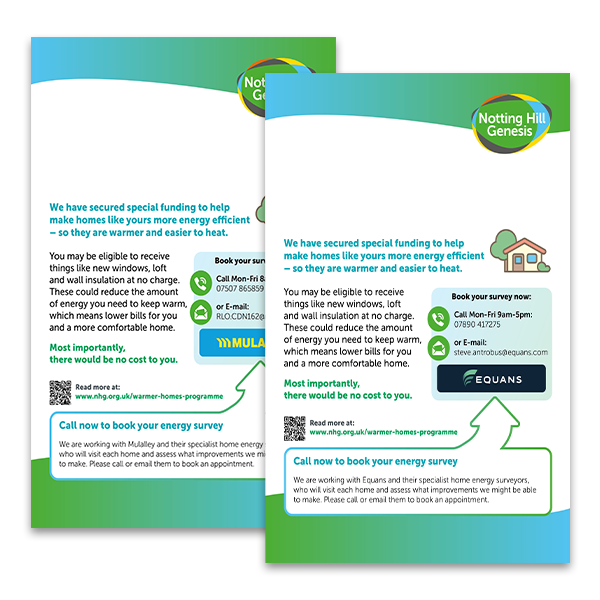We aim to deliver the most suitable improvements to your home – that will help you save on energy bills and feel more comfortable.
There's a lot to consider when making energy improvements - so we've tried to summarise the key steps for you.
We’re working with our trusted contractors – Mulalley and Equans and their accredited installers to improve your home.
Step 1: Book your home energy survey
If we identify your home as potentially eligible for funding, we’ll send you an introduction letter, inviting you to book an appointment for a home energy survey.

Our specialist energy surveyors will visit your home to spot areas for improvement. You'll be able to book your survey by calling the resident liaison officer number in your introduction letter. Our energy surveyors will always carry ID – so you know they’re working for us.
Good to know: Improvements are paid for by Notting Hill Genesis and government funding. There is no cost to you.
To be eligible for our special fund, your home will need to have an energy performance certificate rating of D or lower. At the home energy survey, we'll check this is the case. If your home is not eligible, we'll write to let you know at least 8 weeks following the survey.
Step 2: Making a plan
Once information is received from our energy surveyors, we'll create a plan for your home. Our resident liaison officer will visit to walk you through the improvement options, explain next steps and answer your questions. For certain types of improvement, our resident liaison officer may be able to discuss choices with you. For example, if we're installing a new door, the type and colour of the door.
Good to know: At the visit, our resident liaison officer will find out if anyone in the household has disabilities or specific needs so we can plan extra support as required.
It can take up to 3 months to develop a plan following your survey, especially if we're improving other homes in your street or building. If you haven't heard from us after 12 weeks, get in touch at warmerhomes@nhg.org.uk
Step 3: Your pre-works technical survey
Our specialist installers will pop over to take some measurements and check if your home is suitable for the energy saving measures recommended, or if any extra work is needed.
Good to know: If any repairs are identified that need doing before works start, we'll arrange these with our repair team.
If your home isn't suitable for certain works- we'll give you a call to let you know.
Step 4: The install
Your resident liaison officer will let you know when works are due to start and how long they will take and the times we’ll need access to your home. We'll try and give up to a month's notice so you can make the necessary preparations. If you're having more than one improvement, we'll coordinate activity to minimise disruption and share a schedule of works with you.
Good to know: Our installers are all accredited to a government endorsed standard called PAS2030. You can expect a visit from NHG or our independent surveyors to quality check during installation. Your resident liaison officer will be on hand throughout to answer your questions and help.
Step 5: On completion of the works
Once your improvements have been installed, our team from Equans or Mulalley will go through how you can make the most of these and will offer some energy saving advice.
A representative from NHG will visit your home to check you're happy with your new improvements and that work is finished to a good standard.
Good to know: You'll receive a pack of information about aftercare, how to report faults and contact numbers for when you need advice.
How it works
There's a lot to consider when making energy improvements - so we've tried to summarise the key steps in the process for you.
Efficiency measures
Find out more about the the energy efficiency measures being installed as part of the Warmer Homes programme.
Your home energy survey
Before energy improvements can be made to your home, we need to complete an energy survey.
Marcus Garvey Mews
Hear from staff and residents about how things went at our first location for the Warmer Homes programme.
Our commitments to you
To ensure we meet your needs, we’ve worked with our residents to commit to four key standards.

